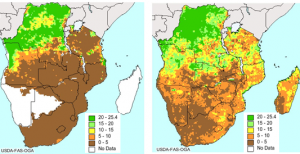From Wade CROW USDA
(left) Within Southern Africa, mid-April 2014 soil moisture fields derived via the USDA FAS water balance model. Data gaps and lack of spatial variability reflect very poor rain gauge coverage in the region.
(right) The analogous field after the assimilation of SMOS L2 surface soil moisture retrievals into the USDA FAS water balance model.
Agricultural drought plays a major role in driving inter-annual variations in agricultural productivity. Therefore, monitoring the availability of root-zone soil moisture is critical for predicting trends in agricultural markets and food availability in food-insecure regions. Recently, the United States Department of Agriculture (USDA) Foreign Agricultural Service (FAS) has begun to assimilate SMOS L2 surface soil moisture retrievals into their global soil moisture monitoring system. USDA FAS analysts use this system to make pre-harvest predictions of variations in global agricultural productivity. In the past, the USDA FAS root-zone soil moisture monitoring system relied on ground-based observations of precipitation and air temperature in order to indirectly estimate root-zone soil moisture via water balance principles. This approach is adequate in data-rich areas of the world like North American and Europe but was known to fail in data-poor (and food insecure) areas of Africa and Central Asian. The assimilation of SMOS surface soil moisture retrievals has, for the first time, given the USDA FAS the ability to accurate track root-zone soil moisture variations within data-poor regions. For example, the image below demonstrates the increase in soil moisture detail within Southern Africa associated with the assimilation of SMOS L2 soil moisture retrievals into the USDA FAS water balance model.
For specific examples of SMOS-based soil moisture products: 1) go here , 2) click on a geographic region of interest, and 3) select “SMOS Surface and Sub-Surface Soil Moisture” from the “Soil Moisture and Crop Models” pull-down tab.
For more information contact: Wade Crow (Wade.Crow@ars.usda.gov) or John Bolten (John.Bolten@nasa.gov) or see http://www.esa.int/Our_Activities/Observing_the_Earth/SMOS/Water_mission_boosts_food_security.
This project was based on funding from the NASA Applied Science Water Resources Program and application-orientated research by the USDA Agricultural Research Service, NASA Goddard Space Flight Center and the National Oceanic and Atmospheric Administration Satellite and Information Service.

